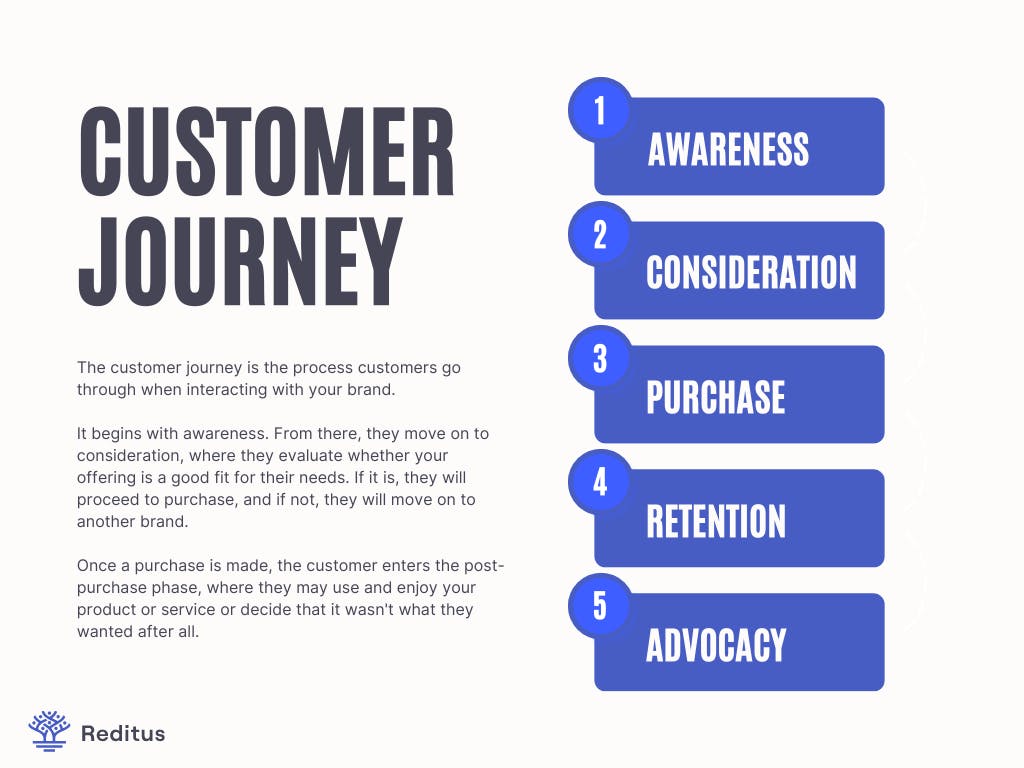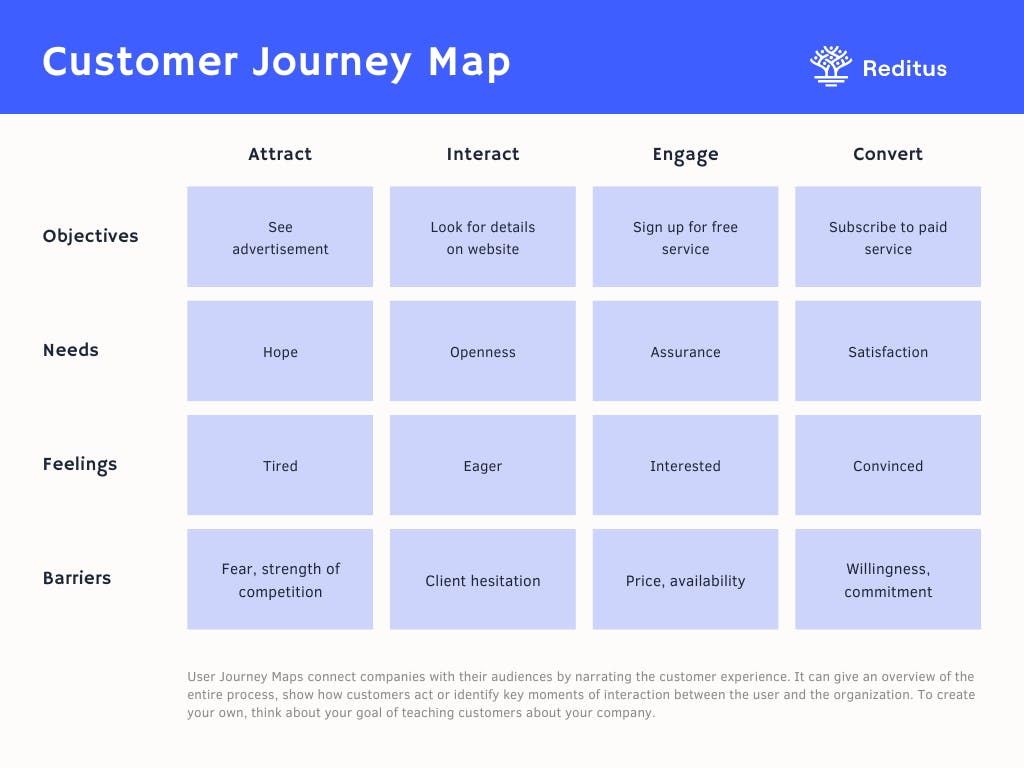Align Your Sales Process With the Customer Journey: Full Guide.

A lot has changed in the sales world over the past few years. To keep up with these changes and continue to be successful, sales teams need to align their process with the customer journey.
Doing so will require a lot of effort and communication between different teams, but it will be well worth it to provide a more seamless customer experience.
This guide will walk you through the steps necessary to make this happen.
Let's start with the basics.
Table of contents
What Is the Customer Journey and Why Should You Care About It?
The customer journey is the process customers go through when interacting with your brand.
It begins with awareness when the customer first becomes aware of your product or service.
From there, they move on to consideration, where they evaluate whether your offering is a good fit for their needs. If it is, they will proceed to purchase, and if not, they will move on to another brand.
Once a purchase is made, the customer enters the post-purchase phase, where they may use and enjoy your product or service or decide that it wasn't what they wanted after all.

Understanding the customer journey is essential for developing a marketing plan that resonates with customers and helps you achieve your business goals.
By understanding how customers interact with your brand, you can create targeted content that speaks to their needs at every stage of the journey.
As a result, you'll be more likely to turn leads into conversions and turn one-time buyers into lifelong fans.
How Do You Map Out the Customer Journey for Your Business?
Now that you know why mapping out the customer journey is critical, let's look at how to create yours.
Even though there are many different ways to map out the customer journey, we'll use a simple three-step process that you can easily follow.
Step 1: Define your buyer personas
The first step in mapping out the customer journey is to define your buyer personas.
A buyer persona is a semi-fictional representation of your ideal customer based on market research and actual data about your existing customers.
Buyer personas are more than demographics like age, gender, or location. They include information about the customer's needs, pain points, and goals.
This helps you understand their goals and how your product or service can help them.
Some companies call them "Ideal Customer Profiles" or "Ideal Customer Avatars."
No matter what you call them, they are essential for understanding your customer and mapping out the customer journey.
Step 2: Identify the multiple touchpoints
The next step is to identify the multiple touchpoints that your customers will have with your brand.
A touchpoint is any interaction a customer has with your brand, whether online or offline.
Some examples of touchpoints include:
- Your website
- Social media
- Advertising
- Sales calls
- In-person meetings
- Customer service
There are endless possibilities for touchpoints, so it's essential to take the time to identify all of the potential ways that your customers could interact with your brand.
Step 3: Plot the customer journey
Now that you've defined your buyer persona and identified all potential touchpoints, it's time to plot the customer journey.
The best way to do this is with a customer journey map.
A customer journey map represents the customer's journey, from awareness to purchase and beyond.
It plots out the different touchpoints that the customer will have with your brand and their needs, pain points, and goals at each stage.

This helps you understand how the customer feels at each stage of the journey and what they need from you to move to the next step.
It also helps you identify potential roadblocks that could prevent the customer from moving forward.
For instance, if a customer is having a negative experience with your customer service, that could prevent them from becoming lifelong fans.
Creating a customer journey map can seem like a daunting task, but there are some simple steps that you can follow to make it easier.
Here's a quick overview of how to create a customer journey map:
Step 1: Choose a format
The first step is to choose a format for your map. There are many different ways to do this, but we recommend starting with a basic linear structure. This will help you visualize the customer journey from start to finish and identify gaps or areas where you could improve the experience.

Step 2: Gather data
Once you have a format in mind, it's time to gather data. This can come from various sources, including customer surveys, interviews, focus groups, and data from your customer relationship management (CRM) system.
Step 3: Plot the journey
Now that you have all your data, it's time to start plotting the customer journey.
Begin by mapping out the different stages of the trip, from awareness to purchase and beyond.
Then, start adding in the different touchpoints that the customer will have with your brand at each stage.
Step 4: Analyze and optimize
Once you have your customer journey map, it's time to start analyzing it for areas of improvement. This is where you can look for ways to streamline the journey and remove any unnecessary steps or pain points.
You can also use the map to identify opportunities for new or improved touchpoints that could enhance the customer experience.
By following these steps, you can create a customer journey map that will help you better understand your customers and optimize their experience with your brand.
What Are Some Common Challenges Involved in the Process?
There are a few challenges that are common when creating customer journey maps. One is that it can be challenging to gather accurate data, especially if you don't have a solid understanding of your customer base.
If you need help figuring out where to start, customer surveys are a great way to get feedback about the customer experience.
Another challenge is that customer journeys are constantly changing, so it's essential to review and update your map regularly.
Many businesses make the mistake of creating a customer journey map and then forgetting about it. But if you want it to be helpful, you must keep it up-to-date.
Finally, it's important to remember that the customer journey is not always linear. In reality, customers often take detours, backtrack, or jump ahead at various points in the journey.
This can make it tricky to map out, but it's essential to consider these possibilities when creating your customer journey map.
Some other common mistakes might include the following:
- Not starting with the customer in mind: The customer should be the focus of the journey map, not the product or service.
- Failing to account for all touchpoints: The customer journey includes all of the interactions that the customer has with your brand, not just the ones that happen online.
- Ignoring post-purchase behavior: The journey doesn't end when the customer makes a purchase. You must consider what happens after they buy, including customer service, retention, and loyalty.
- Not making it actionable: The customer journey map should be a tool you use to improve the customer experience. If it's not actionable, it's not going to be helpful.
How can you overcome these challenges and create a seamless customer experience?
Creating a seamless customer experience can be challenging, but you can do a few things to overcome common obstacles.
First, make sure you have a clear understanding of your customer's needs and pain points.
- What are they trying to achieve?
- What are their biggest challenges?
Once you understand your customer's goals, you can start mapping the customer journey.
- What steps do they need to take to achieve their goal?
- Where do they need help?
Identifying potential roadblocks and designing around them can help you create a smoother customer experience.
The key is to start with the customer in mind and then work backward. Once you have a solid understanding of your customer base, you can begin mapping out their journey and identifying areas for improvement.
It's also important to regularly review and update your customer journey map as the customer experience evolves. By doing this, you can ensure that your map always stays relevant and actionable.
Some other things to consider might include:
- Offering a variety of touchpoints: Customers should be able to interact with your brand in a way that is convenient for them. This might include online, in-store, over the phone, or social media.
- Making sure your journey is consistent: All of the touchpoints in the customer journey should be consistent with each other. This means having a clear brand message and ensuring that all customer-facing employees are on the same page.
- Providing excellent customer service: Customer service is a critical part of the journey, and it's essential to ensure that your team provides the best possible customer experience at every turn.
- Focusing on the customer: Every journey step should focus on the customer and their needs. This means understanding what they want and delivering it in a way that exceeds their expectations.
Also, remember to test, test, and test.
Try out different versions of your customer journey and measure the results.
By constantly refining and optimizing your process, you can ensure that your customers always have a positive experience.
Conclusion
As a SaaS founder, it's essential to deeply understand the customer journey to align your sales process with it.
By mapping out the customer journey and being aware of common challenges, you can create a seamless experience for your customers that will lead to increased sales.
Hopefully, this article provided enough information to help you design your customer journey map on the right foot.

